What Does The 👼 Baby Angel Emoji Mean? [Emojiology]
![What Does The 👼 Baby Angel Emoji Mean? [Emojiology]](/content/images/size/w2000/2018/12/Emoji-Header-Baby-Angel-Emojipedia.jpg)
As we saw in our Emojiology on 👻 Ghost, Halloween is downright haunted by emojis to mark the occasion. Close behind it, on the holiday front, is Christmas. From a 🎁 Gift under the 🎄 Christmas Tree to a 🍪 Cookie and 🥛 Glass of Milk set out for 🎅 Santa Claus, we have a sleighful of emojis for our digital Yuletide.
But among the Christmasy emojis is one whose seasonal significance may be less obvious to some: 👼, or Baby Angel. Its symbolism is rich and ancient—and, as we’ll see, flies to the very nature of emojis themselves. Let's get this Emojiology its wings.
🔤 Meaning
Depicting a child with a halo and wings, 👼 Baby Angel can represent a biblical cherub, mythological cupid, decorative putto, or an angel as a supernatural being in general. It is often used to express affection for people, especially children at birth or, more sadly, after death. 👼 Baby Angel marks a wide range of content concerning love, Valentine's Day, positive feelings like gratitude, and the Christian faith, especially during Christmas.
💬 Development
👼 Baby Angel was added to the Unicode Standard in 2010 but was hovering over Japanese keyboards as early as 2000. That’s when SoftBank, for one, featured the full figure of a naked, chubby child with angel wings and a halo.
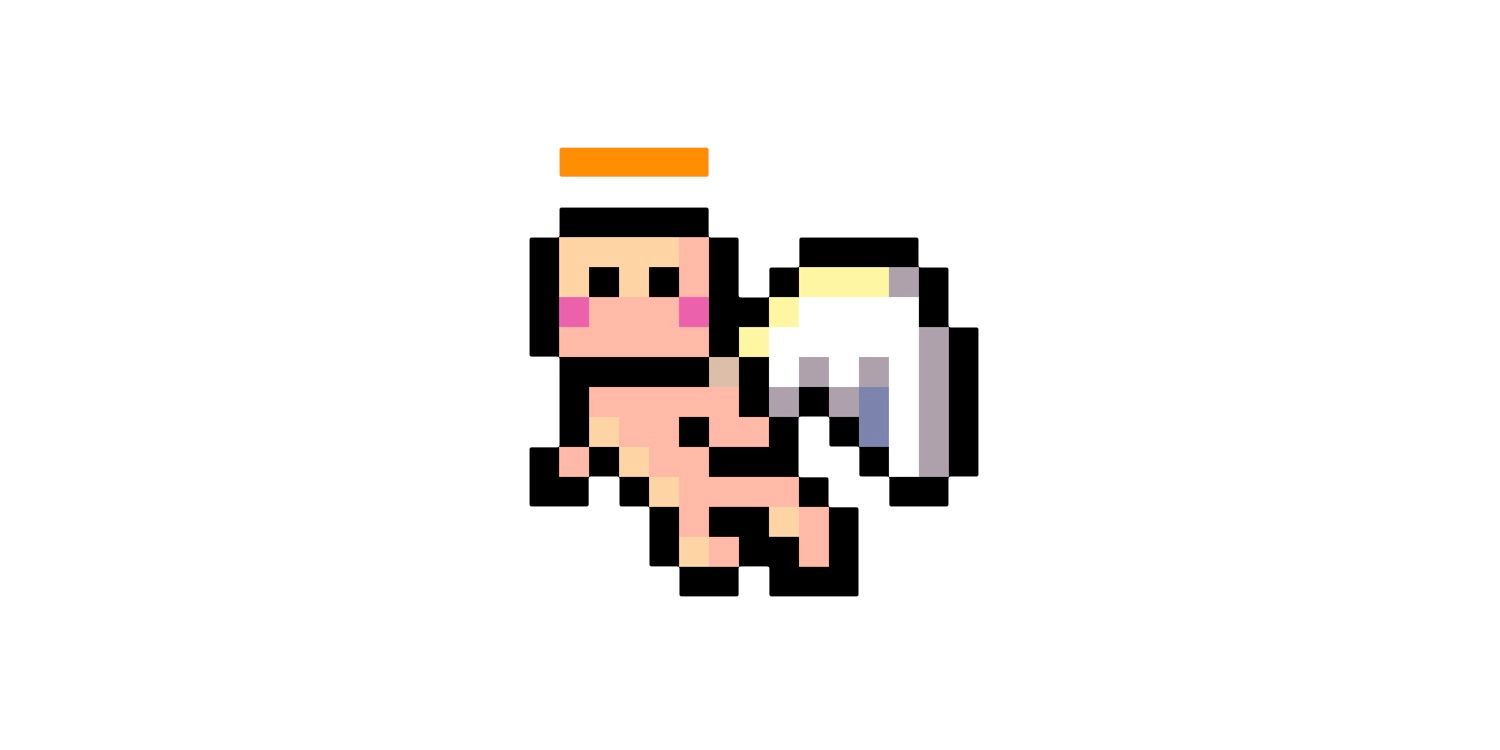
When Apple first supported emojis on iPhone OS 2.2 in 2008, it rendered 👼 Baby Angel as the head of a white-skinned boy with a blue halo over his light brown hair and the white, leaf-like wings at his neck.
His facial expression suggested a stoicism and even, ironically, devilish mischief that many thumbs miss—though perhaps not more so than Google’s truly divine blob.
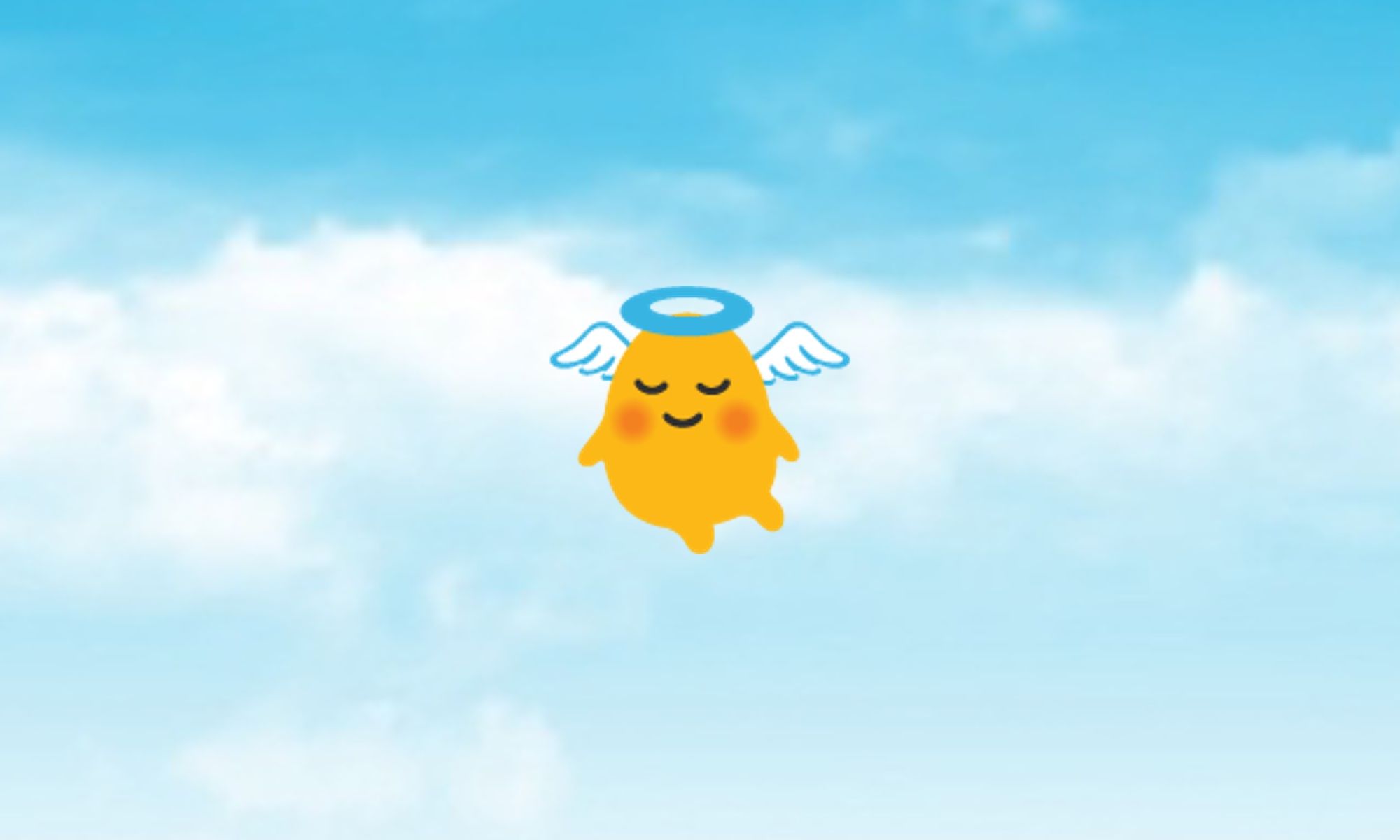
For iOS 5.1, Apple opened 👼 Baby Angel's slight smile. It kept the mouth agape for iOS 8.3 but, with the addition of skin-tone modifiers in 2015, shaded his default color to yellow.
the old one outsold... feel like pure shite just want her back https://t.co/jSu9WRrImf
— savannah (@hopskipstep) November 25, 2018
In 2016, iOS 10.0 brought 👼 Baby Angel into its current form. It displays as the head of gender-neutral baby with ears and a curly lock of hair. The head is crowned with a golden halo, a symbol of holiness, and is aloft on more feather-styled wings.
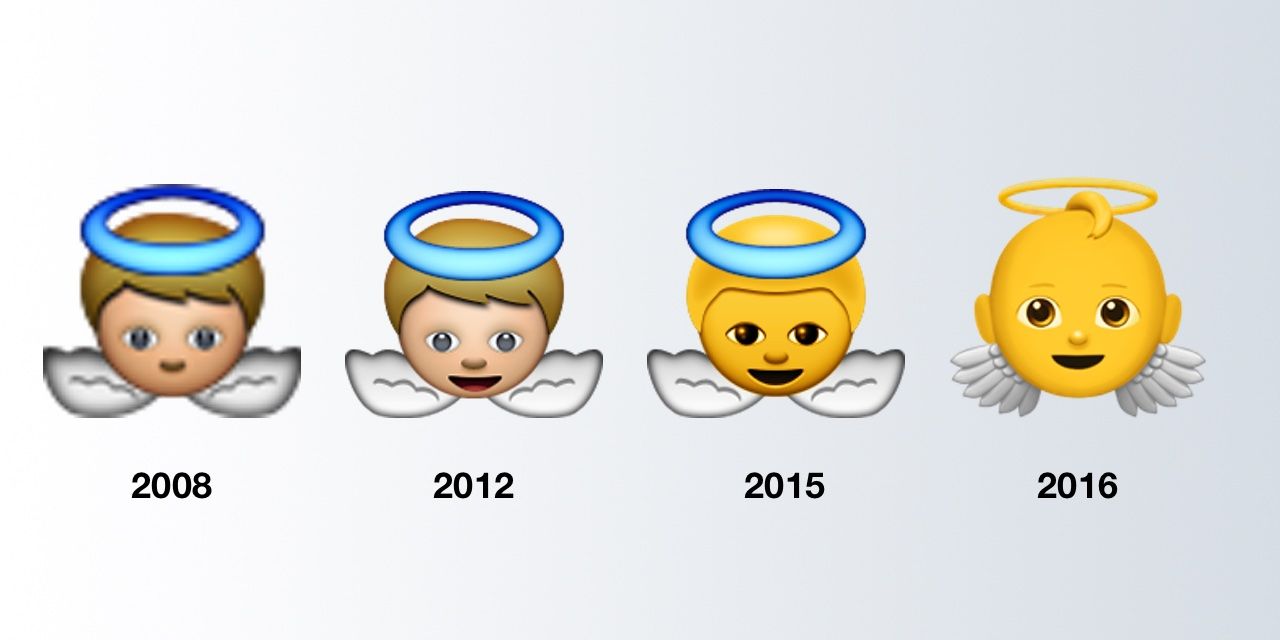
Most similar to Apple’s 👼 Baby Angel design are Facebook’s and Samsung’s, but with a brown tuft of hair. Google and Microsoft feature blue halos and brown and blonde hair, respectively. WhatsApp positions its wings on a bust.
Twitter, in keeping with the rest of their emojis, displays red / orange hair when no specific skin tone option is selected.
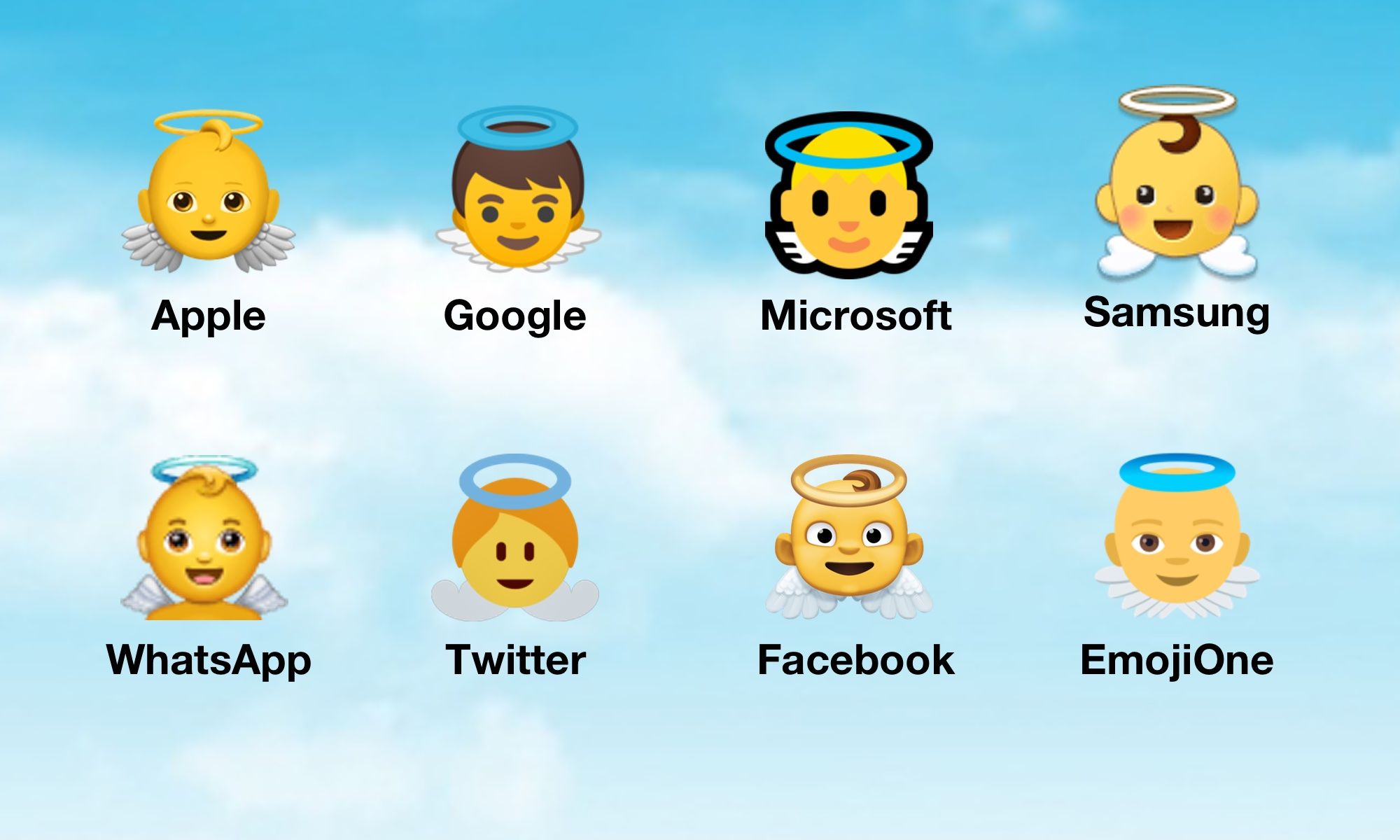
📜 Pre-Emoji Era
Nearly 20 years old, 👼 Baby Angel, as an emoji, isn’t a baby anymore, so to speak. In iconography, however, the figure of a baby angel is much, much older.
According to art historians and classical scholars, the contemporary imagery of baby angels originate as depictions as young male spirits on ancient Roman sarcophagi. They were daemones or genii—source of our words demon and genius, yes, but originally minor divinities that attended on or inspired people throughout their lives, not unlike guardian angels.
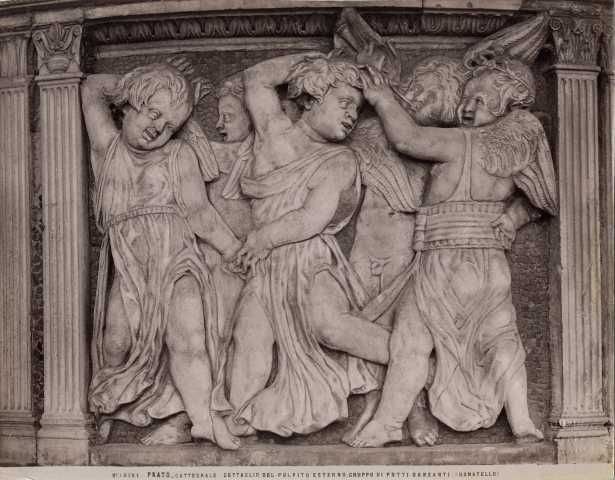
Italian Renaissance artists, notably Donatello, transformed them into the now-iconic plump infants called putti (singular, putto, Italian for “boy”). For a 2016 exhibition she curated, Dr. Cora Gilroy-Ware provided an interpretation of putti very apt for our purposes here:
Inspired by the demonic infants on ancient Roman sarcophagi, artists of the Florentine Renaissance employed the putto as a decorative framing device that could help animate an artwork and steer the viewer toward its overarching significance. It is in this sense that the putto prefigures the emoji. In the same way that emojis are used to express our emotions and refine the meaning of text, putti visualised otherwise intangible feelings, usually those experienced by the main (adult) actors in a carved or painted work.
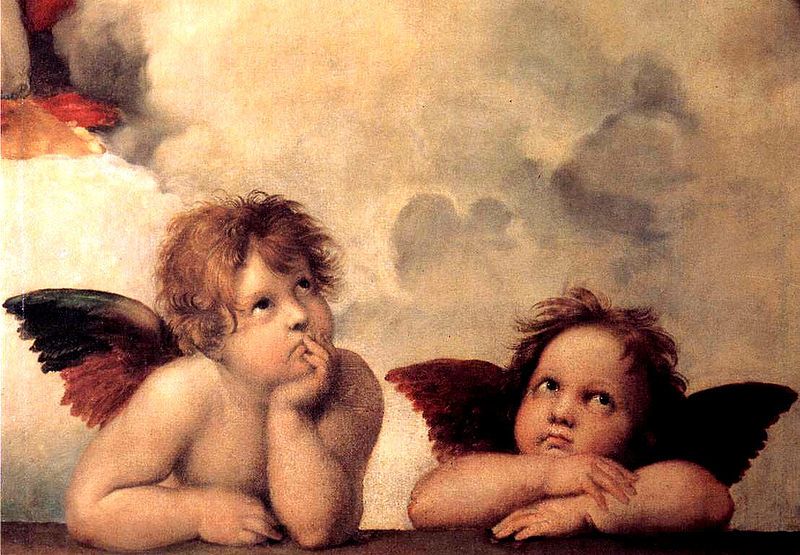
These proto-emojis went on to adorn countless paintings, sculptures, architectural features, and monuments over the centuries, variously signifying religious, celebratory, mischievous, or musical sentiments or ideas. Grafted onto putti were cupids and cherubs.
Cupids represent the Roman god of love, Cupid, who took the form of a naked, winged boy with a bow and arrow, hence his association with Valentine’s Day today. His flight and youth are said to symbolize love’s fickleness and impulsivity. While cherubim in the Old Testament of the Bible are unearthly human-animal protectors originally distinct from angels, the beings morphed into baby angels in Christianity.
Angels are central to the Nativity, or the story of the birth of Jesus Christ that Christians celebrate at Christmas. In the Gospels of the New Testament, an angel reveals to Mary, Jesus’ mother, that she will carry the son of God as conceived by the Holy Spirit. An angel also informs Joseph, her husband, that he will foster-father Jesus. Angels rejoice over Bethlehem upon Jesus’ birth—or, as many of us know it from the Christmas song, Hark! he herald angels sing, "Glory to the new-born King!”
Christ is born in Bethlehem 👼
— Logan (@Lowguine) December 25, 2013
The Christ child, and the role of angels in his birth, make 👼 Baby Angel perfectly suited for our Christmastime screens. Angels as Christmas tree toppers and ornaments also nod to the angels in the Nativity story. And you better believe you can deck your halls with emojis.
Eek! Can you believe it's the 1st of December on Saturday? We're putting the #Christmas tree up in the office on Monday. Do you remember putting up the tree when you were younger? Did you have an angel or star on top? #throwbackthursday 🎄👼⭐ pic.twitter.com/36yqxCdNzH
— EducationCity (@EducationCity) November 29, 2018
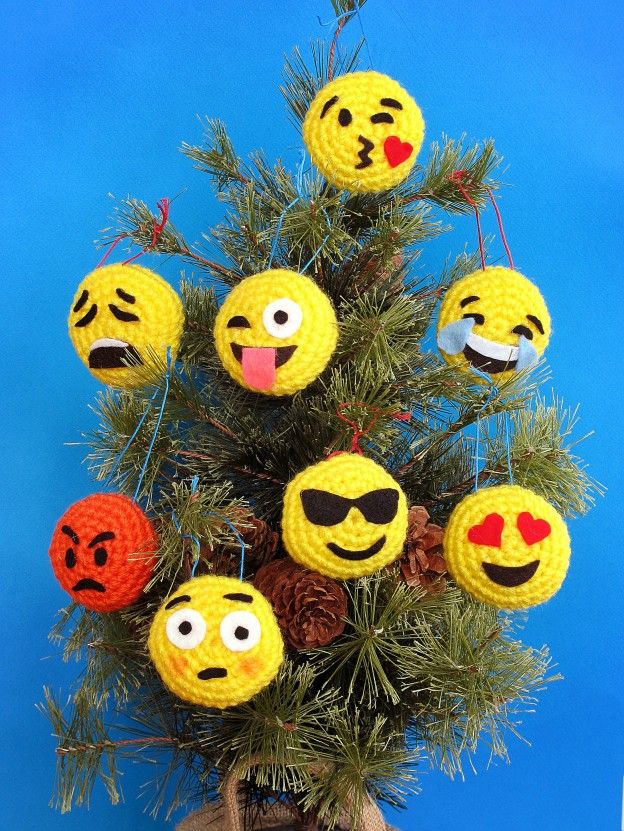
✅ Examples
If, as Dr. Gilroy-Ware observes, its putto predecessors express such emotions as romance and merriment in art and architecture, then what sort of feelings does 👼 Baby Angel express?
Romance and merriment, for two things, if 👼 Baby Angel’s appearances around Valentine’s Day and Christmas are any measure.
happy Valentine's Day my loves. thank you for making my life sparkle again. 👼❤ #iloveyou
— Amber Scholl (@AmberScholl) February 14, 2017
Season's greetings.. 👼🏻👼🏻👼👼🏾🎄🎄🦌🎅🏼 #paskoNaNaman pic.twitter.com/hDO4cZwsRN
— PE (@perdz4ever) November 30, 2018
Outside these holidays, 👼 Baby Angel is widely used as a pictograph of endearment, if you will. It can stand for or alongside pet terms like baby, angel, and, of course, the duo baby angel. This is very common for birth announcements and suggests purity, innocence, goodness, and joy.
the BIGGEST blessing 👣👼❣️ pic.twitter.com/G2HWS2bNG0
— Charli🧚♀️ (@CharliFalcon) November 30, 2018
Good night baby 👼 💕💕💕💕 pic.twitter.com/8TVx1vOLIL
— ปลาตีน'น้อยยย (@Plateen4G) November 30, 2018
On a sadder note, 👼 Baby Angel also sees use in remembrances of loved ones who have passed away, with the emoji engaging ideas and images of heaven.
Today we lost a true artist. Thank you #Prince for all the music you put into this world. #RIP 👼
— Chris Frank (@Chriis_Frank) April 21, 2016
RIP 41st President George H.W. Bush
— ☆ Andrea ☆ (@Tao_30) December 1, 2018
They're together again. 💖👼 pic.twitter.com/DvYW0gEoGE
As angels are especially important figures in Christian belief, 👼 Baby Angel can expression various religious sentiments, not to mention its applications to all things angels in myth and fantasy.
Good night, my friends. May our prayers and faith be filled with the trust and love of a child. Mutual prayers and blessings. See you tomorrow. 🙏💞🙏📿👼 pic.twitter.com/3Uk6Y05mnx
— Sr. Veronica Paul (@sistervpaul_) November 30, 2018
By metaphorical extension, 👼 Baby Angel can communicate a sense of the “miraculous” or “blessed.”
It feels like a miracle, the two BLM Mustangs at Texas kill pen are SAFE!! Big thank you to @GailQuiros for making this possible and to @MaeMartini1 & @SarlisSioux for organizing their rescue! There is always hope!! 👼💕#FridayFeeling #thankful #happy #wildhorses #horses #rescue pic.twitter.com/zN4Jp7hu5g
— Freedom4Horses (@Freedom4Horses) November 30, 2018
It's my 21st birthday today what a great day to praise the lord ☝️👏👼
— mr. sauce (@tehgerse) January 7, 2018
👼 Baby Angel isn’t always so angelic, however. The emoji is sometimes used with irony to suggest its very opposite: that someone or something is being a bit diabolical 😈.
I made rice, beans and pollo al horno but this strawberry cheesecake I'm not sharing i made it just for me. 😇👼😇 pic.twitter.com/rFelOKZ2mX
— Deb (@Debbie36030761) November 30, 2018
🗒️ Usage
Many supernatural beings populate emojidom, including our friendly 👻 Ghost, 👽 Alien, 👹 Ogre, 🧙 Mage, 🧚 Fairy, 🧛 Vampire, 🧜♀️ Mermaid, 🧞Genie, 🧟 Zombie, and, also hard at work during Christmas, 🧝 Elf. There’s no Angel as such yet—though maybe you have hope, one of the many meanings of 👼 Baby Angel.
We do have, however, 😇 Smiling Face With Halo, whose angelic countenance often accompanies 👼 Baby Angel and amplifies its various senses, from Christmas cheer to newborn dears. Other emojis you can expect to see alongside 👼 Baby Angel are ✝️ Latin Cross, for overtly Christian an content; 🙏 Folded Hands, for blessings, gratitude, and praise, religious or not; other Christmas-themed emojis, from ☃️ Snowman to 🔔 Bell; and any number of heart-based emojis, especially the Cupid-evoking 💘 Heart With Arrow.
Voltaire—oh, you didn't know emojis were so cultured and well read?—once wrote:
It is not known precisely where angels dwell whether in the air, the void, or the planets. It has not been God's pleasure that we should be informed of their abode.
As far as we’re concerned, we know one place where we can find them, though. They aren’t dancing on the head of pin, but they are certainly all over our keyboards. 👼⌨️👼📱👼
